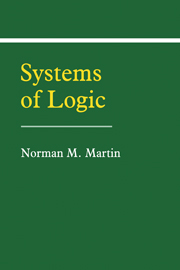Book contents
- Frontmatter
- Contents
- Preface
- 1 Formal Systems and Structure Theory
- 2 Zero-Order Logic: Proof Theory
- 3 Zero-Order Model Theory
- 4 Positive Implication
- 5 Negation
- 6 Complete Implication-Negation Logic
- 7 Disjunction
- 8 Conjunction
- 9 Multi-Connective Systems
- 10 Strict Implications: Introduction
- 11 Strict Implications: Additional Results
- 12 Quantification and First-Order Logic
- 13 Quantification and Complete Logics
- 14 Quantification and Incomplete Logics
- 15 Interpretation of Formal Systems
- Appendix: Historical and Bibliographical Remarks
- Subject Index
- Index of Systems
- Index of Symbols
12 - Quantification and First-Order Logic
Published online by Cambridge University Press: 12 March 2010
- Frontmatter
- Contents
- Preface
- 1 Formal Systems and Structure Theory
- 2 Zero-Order Logic: Proof Theory
- 3 Zero-Order Model Theory
- 4 Positive Implication
- 5 Negation
- 6 Complete Implication-Negation Logic
- 7 Disjunction
- 8 Conjunction
- 9 Multi-Connective Systems
- 10 Strict Implications: Introduction
- 11 Strict Implications: Additional Results
- 12 Quantification and First-Order Logic
- 13 Quantification and Complete Logics
- 14 Quantification and Incomplete Logics
- 15 Interpretation of Formal Systems
- Appendix: Historical and Bibliographical Remarks
- Subject Index
- Index of Systems
- Index of Symbols
Summary
Before starting our discussion of first-order systems, we want to point out that the expressive means provided in zero-order logic (variables and connectives), though simple, essentially exhaust what can be said on a single level (with a partial exception soon to be noted). Connectives provide in principle the means of expressing any transformation - provided the property in question holds of all wffs, a restriction implied by saying that we are talking about logic. From this point of view connectives can be considered the structural correlate of transformations from wffs to wffs that we have called wff functions.
The most basic feature of our generalization is that we provide two levels of well-formed expressions, called respectively terms and well - formed formulae (wffs). We will in addition want to extend the expressive means in two directions. The first of these generalizations consists of allowing operators whose character (“value”) and arguments are allowed to vary over the elements of either of the levels, though each argument position of these operators will be restricted to one level or the other. The second extension involves a kind of indexed operator of which the familiar universal and existential quantifiers are the best known examples.
Accordingly, our formal presentation is generalized so that our infinite family of sets {Sa} runs over an index set such that a decomposes into a natural number i and a sequence of i+1 0's and 1's.
Information
- Type
- Chapter
- Information
- Systems of Logic , pp. 238 - 259Publisher: Cambridge University PressPrint publication year: 1989
